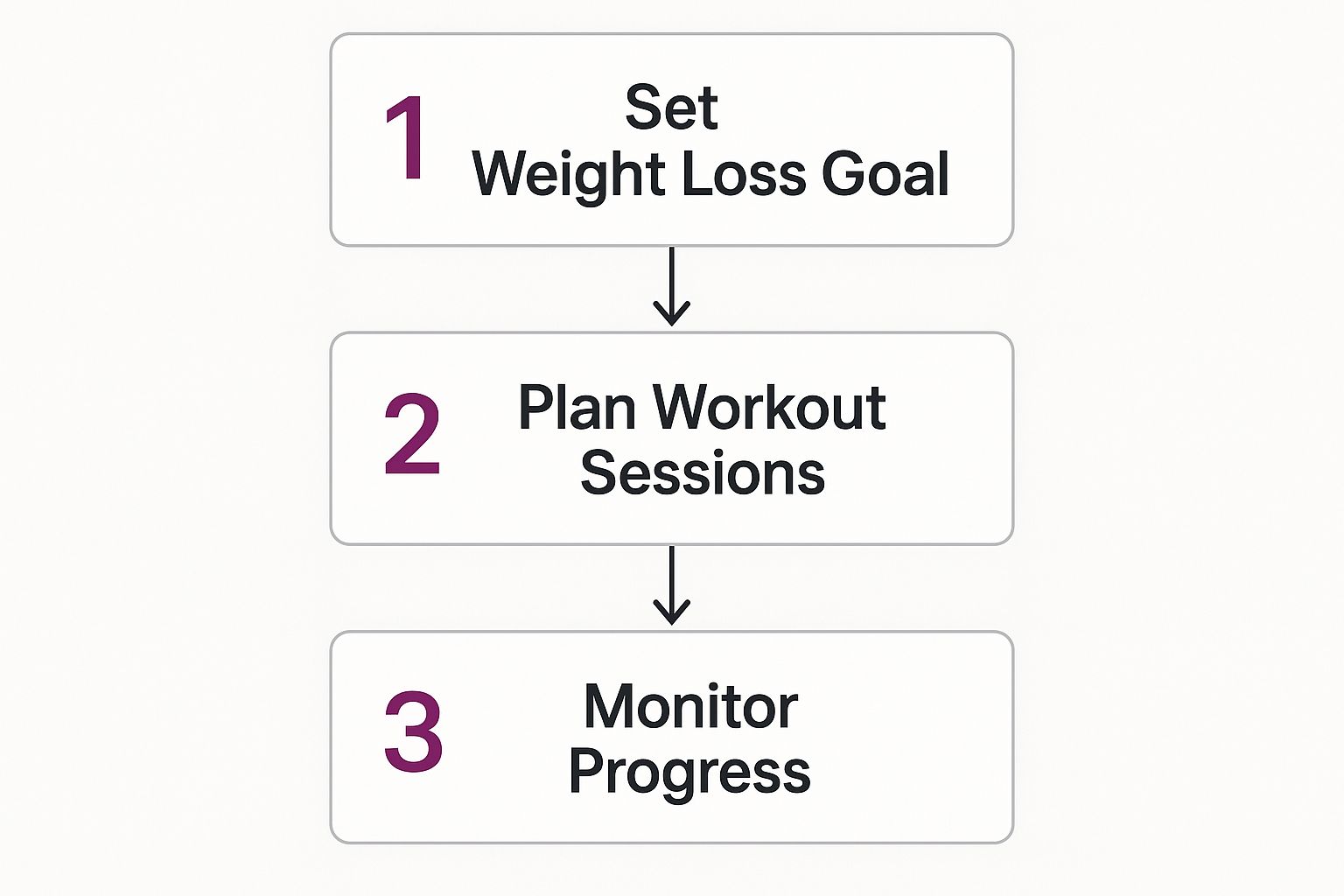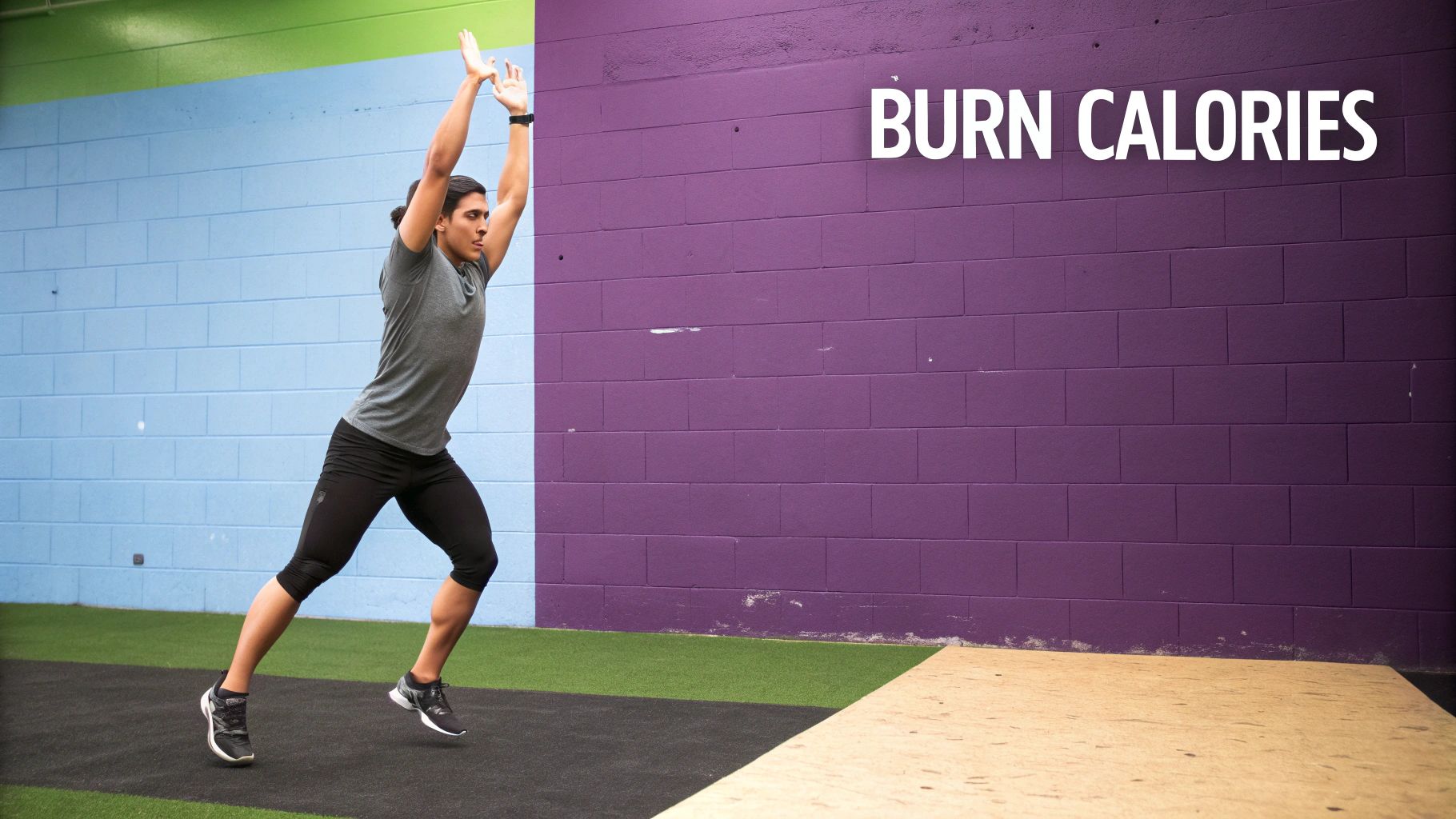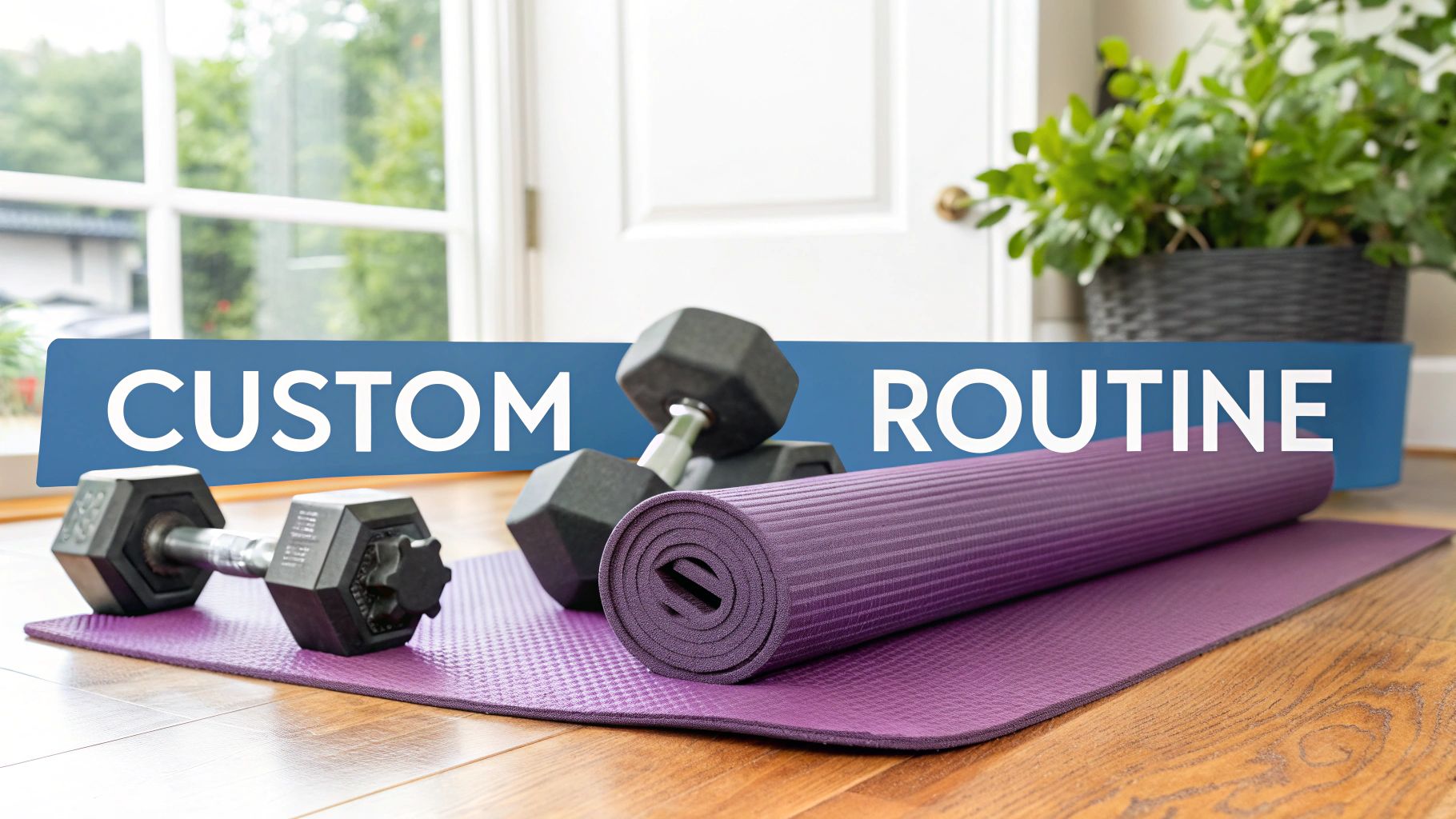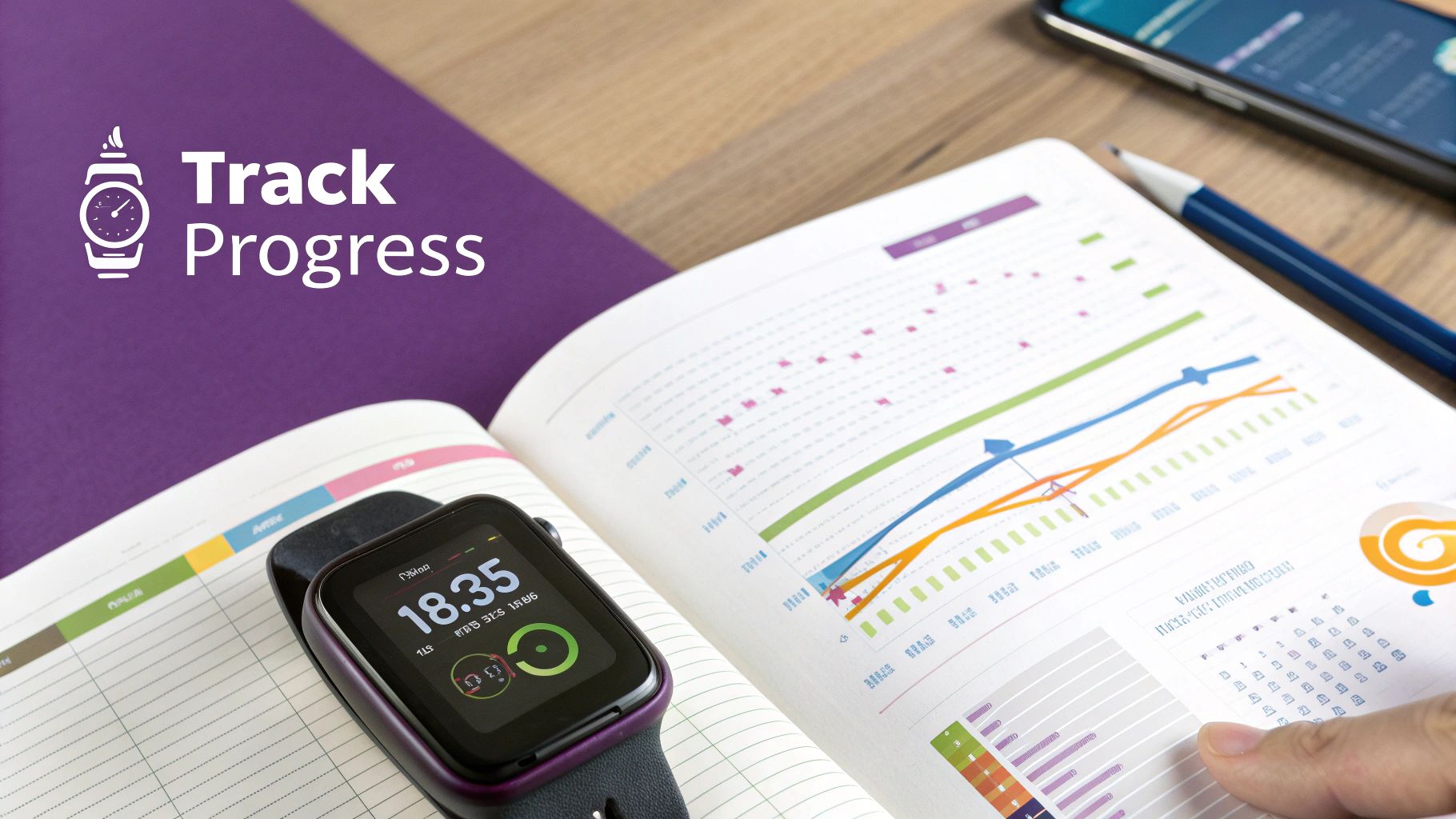
A Workout Routine for Weight Loss That Delivers Results
Building a workout plan for weight loss is most effective when you combine cardio and strength training. This powerful duo is the secret to success. You not only burn calories during your workout but also build a body that's better at burning fat all day long.
At Diet & Exercise Shop, we believe the right gear makes your fitness journey smoother and more effective. Our products are designed to support every step of your workout routine.
Your Foundation for an Effective Weight Loss Workout
Starting a fitness journey can feel confusing. But the path to weight loss is simpler than you think. It's not about exercising more, but exercising smarter. A balanced routine that tackles fat loss from all sides is key.
The goal is to mix activities that raise your heart rate with exercises that build lean muscle. This combination is the cornerstone of any successful weight loss plan.
Combining Cardio and Strength for Maximum Impact
Cardio, or aerobic exercise, is fantastic for burning calories and improving heart health. This includes activities like brisk walking, running, cycling, or using an elliptical machine. These workouts are crucial for creating the calorie deficit needed for weight loss.
Strength training is your secret weapon for long-term success. Lifting weights or using resistance bands builds lean muscle. The more muscle you have, the higher your resting metabolic rate. This means your body burns more calories, even at rest.
The real magic happens when you combine cardio and strength training. Cardio burns calories now, while strength training turns your body into a long-term fat-burning machine.
Industry data consistently shows that combining aerobic and resistance training is a highly effective way to lose weight and reduce body fat. Research suggests at least 150 minutes per week of aerobic exercise can significantly increase calorie burn. Adding 2–3 strength training sessions helps preserve muscle, boosting your metabolism. You can explore more about these industry findings to see the data.
The Critical Role of Nutrition
Exercise is only half the equation. Your diet fuels your workouts and helps your muscles recover. You can't out-train a poor diet, making mindful eating essential.
Focus on a balanced diet with lean proteins, complex carbs, healthy fats, and plenty of vegetables. Protein is especially important for muscle repair and keeping you full, which helps manage calorie intake. Food and exercise must work together.
This simple graphic shows how to structure your approach.

Set a clear goal, plan your workouts, and track your progress. A great routine is flexible and adapts as you get stronger.
Putting It All Together: Your Weekly Schedule
So, what does a balanced week look like? It's about mixing workout days with rest days to allow your body to recover. Pushing too hard can lead to burnout or injury.
Here is a sample schedule. Feel free to swap the examples with exercises you enjoy.
| Day | Focus Activity | Example | Duration |
|---|---|---|---|
| Monday | Full-Body Strength | Squats, Push-ups, Rows, Lunges, Overhead Press | 45-60 minutes |
| Tuesday | Moderate Cardio | Brisk Walking or Cycling | 30-45 minutes |
| Wednesday | Full-Body Strength | Deadlifts, Bench Press, Pull-ups, Glute Bridges | 45-60 minutes |
| Thursday | HIIT Cardio | Sprints on a treadmill or bike (1 min on, 2 min off) | 20 minutes |
| Friday | Full-Body Strength | Kettlebell Swings, Goblet Squats, Planks | 45-60 minutes |
| Saturday | Active Recovery | Light Yoga, Stretching, or a long, easy walk | 30 minutes |
| Sunday | Rest | Complete Rest | - |
This schedule includes three strength days, two types of cardio, and time for recovery. Remember, this is a template. The best plan is one you can stick to.
Building Your Cardio Routine To Burn Calories
Cardio workouts are your primary tool for burning calories. To be effective, you need a plan. Two popular styles are High-Intensity Interval Training (HIIT) and Low-Intensity Steady-State (LISS). Both are great for fat loss but suit different needs.

High-Intensity Interval Training (HIIT)
HIIT involves short, intense bursts of exercise followed by brief recovery periods. For example, sprint for 30 seconds, then walk for 60 seconds, and repeat.
A HIIT session usually lasts 15–25 minutes but continues to burn calories long after you finish due to the "afterburn effect." It's perfect for busy schedules.
Here's a no-equipment HIIT circuit:
- Jumping Jacks: 45 seconds work, 15 seconds rest
- High Knees: 45 seconds work, 15 seconds rest
- Burpees: 45 seconds work, 15 seconds rest
- Mountain Climbers: 45 seconds work, 15 seconds rest
- Recovery: 1 full minute
- Repeat 4 times
Low-Intensity Steady-State (LISS) Cardio
LISS involves maintaining a steady, moderate pace for 30–60 minutes. Examples include brisk walking, easy jogging, or cycling.
This style is less intense than HIIT but is a reliable way to burn calories and build endurance. It's also great for active recovery days.
A mix of HIIT and LISS ensures you burn fat effectively while allowing for proper recovery.
The Perfect Cardio Machine For Home Workouts
Having the right equipment at home makes it easier to stay consistent. Our Endurance Cardio Machine is versatile enough for any cardio workout, from sprints to steady-state sessions.
Key Features:
- Adjustable Resistance: Easily switch between different intensity levels.
- Dual Use: Perfect for both HIIT and LISS workouts.
- Smooth Transitions: Quickly change settings between intervals.
This machine supports any goal, whether it's a quick 20-minute blast or a 45-minute endurance ride. It's the ideal partner for your home workout routine for weight loss.
Nailing Your Form For Maximum Results
Proper form is crucial. It maximizes your calorie burn and reduces the risk of injury. Taking time to learn the basics will make every workout more effective.
For a detailed guide, watch our High-Energy Cardio Form Tutorial on the DietExercise YouTube channel. You'll learn how to maintain good posture and engage the right muscles.
Don't Forget Strength Training to Fire Up Your Metabolism
Cardio burns calories, but strength training provides long-term benefits for a leaner body. Building muscle boosts your resting metabolism, meaning you burn more calories all day, even at rest.
Strength training is too powerful to ignore in a weight loss plan. More lean muscle means your body needs more energy to maintain itself, making it easier to stay in a calorie deficit.

Your Full-Body Strength Essentials
For weight loss, a full-body routine two to three times a week is ideal. This approach works all major muscle groups and allows for recovery, which is when muscle growth happens.
Focus on compound exercises, which work multiple muscle groups at once. They are incredibly efficient for your workout routine.
Build your routine around these core movements:
- Squats: Target your quads, hamstrings, and glutes.
- Presses: Build upper-body "pushing" muscles with overhead or bench presses.
- Rows: Improve posture and "pulling" strength with bent-over rows.
- Hinges: Work your glutes, hamstrings, and lower back with deadlifts.
Master these key compound movements for a solid foundation. Quality is more important than quantity.
The Right Tools for the Job
You don't need a commercial gym for a great strength workout. A few versatile pieces of equipment at home can be just as effective.
Our Adjustable Dumbbell Set is a game-changer. It replaces an entire rack of weights, saving space while providing a wide range of options. This is perfect for progressive overload, where you gradually increase the weight to keep making progress.
Our Resistance Band Kit adds variety and is great for targeting smaller muscles. These bands are light, portable, and perfect for exercises like glute bridges and bicep curls. You can get a great workout anywhere. For more ideas, check our guide on home gym equipment essentials.
Putting Your Strength Workout Together
Let's create a plan. Always focus on good, controlled form to feel the right muscles working.
Here's a sample full-body workout using our recommended gear:
| Exercise | Sets | Reps | Equipment Used |
|---|---|---|---|
| Goblet Squats | 3 | 8-12 | Adjustable Dumbbell |
| Dumbbell Bench Press | 3 | 8-12 | Adjustable Dumbbell |
| Bent-Over Rows | 3 | 8-12 | Adjustable Dumbbell |
| Banded Glute Bridges | 3 | 15-20 | Resistance Band |
| Dumbbell Overhead Press | 3 | 8-12 | Adjustable Dumbbell |
| Plank | 3 | 30-60 sec | Bodyweight |
Perform this routine two or three times a week on non-consecutive days, like Monday, Wednesday, and Friday. This gives your muscles the crucial 48 hours they need to recover.
When exercises become easier, increase the weight on your dumbbells or use a stronger resistance band. This constant challenge is key to seeing results.
Fueling Your Body the Right Way for Weight Loss
A great workout routine needs the right nutrition to be effective. Your diet is the fuel that powers your workouts and helps your body recover. You simply can't out-train a bad diet.
Connecting your hard work in the gym with smart habits in the kitchen is essential for achieving the results you want from your workout routine for weight loss.
Understanding the Calorie Deficit
The foundation of fat loss is a calorie deficit. This means you need to burn more calories than you consume. Your body then uses stored fat for energy, leading to weight loss.
A moderate and sustainable deficit is key. Pairing your workouts with a smart eating plan makes this much easier. For more details, read our guide on what a calorie deficit is.
The global weight loss market was valued at USD 297 billion in 2024 and is projected to reach nearly USD 590 billion by 2033. This shows a growing focus on health through fitness and nutrition. Discover more insights about these market trends.
Balancing Your Macronutrients
Not all calories are the same. The source of your calories—protein, carbs, and fats—matters. A balanced intake of these three "macros" is crucial for success.
Each macronutrient has a specific role, and understanding them helps you build better meals.
Macronutrient Guide for Weight Loss
Here's a quick look at why each macronutrient is important for your weight loss journey.
| Macronutrient | Role in Weight Loss | Healthy Food Sources |
|---|---|---|
| Protein | Essential for muscle repair and growth. It also keeps you feeling full and boosts metabolism. | Lean meats (chicken, turkey), fish, eggs, Greek yogurt, lentils, beans, and tofu. |
| Carbohydrates | Your body's main energy source. Carbs fuel your workouts and replenish muscle energy stores. | Oats, brown rice, quinoa, sweet potatoes, fruits, and vegetables. |
| Fats | Crucial for hormone function and vitamin absorption. Healthy fats help you feel satisfied after meals. | Avocados, nuts, seeds, olive oil, and fatty fish (like salmon). |
Balancing these macros ensures your body has everything it needs to perform, recover, and burn fat.
The Power of Protein and Smart Tools
If you're lifting weights, protein is non-negotiable. It helps repair the tiny tears in your muscle fibers created during training, making them stronger.
Hitting your daily protein goal can be challenging. This is where supplements can help.
Our Premium Protein Powders are a convenient way to support muscle recovery. A post-workout shake is a simple and effective habit.
Consistency is key, and meal prepping can help. Use our Healthy Meal Prep Containers to plan and portion your meals. This ensures you always have a healthy option ready. For ideas, watch our video on Easy Meal Prep for Weight Loss. Combining the right fuel with the right tools creates a powerful system for success.
Tracking Progress and Staying Motivated
Starting a workout routine is one thing; sticking with it is another. Consistency is crucial, but it's easy to lose motivation if you don't see results immediately. Effective progress tracking is your secret weapon.
Progress shows up in many ways beyond the scale. Learning to spot these changes will keep you motivated.

Look Beyond the Scale
The bathroom scale can be misleading. It shows your total body weight but doesn't distinguish between fat, muscle, and water.
When you start strength training, you build lean muscle, which is denser than fat. Your clothes may fit better, but the number on the scale might not change much. This can be discouraging if you're not tracking other metrics.
Don't let the scale define your progress. Celebrate "non-scale victories" like clothes fitting better or having more energy.
For a clearer picture of your body composition, you need better tools. Our Smart Body Composition Scale tracks metrics like body fat percentage and muscle mass. Seeing your muscle mass increase while body fat decreases is incredibly motivating.
Leverage Technology to Stay Accountable
Modern technology makes tracking your efforts easier than ever. Fitness trackers have become sophisticated tools for monitoring your health.
The global market for exercise and weight loss apps was valued at USD 980 million in 2024 and is expected to grow by 17.4% annually through 2030. People want actionable data. Discover more insights about these health tech trends.
Pairing your routine with an Advanced Fitness Tracker from our shop can be a game-changer. It logs workouts, monitors heart rate, and tracks sleep—a key factor in recovery.
Practical Tips for Long-Term Motivation
Staying motivated requires smart habits and supportive systems.
Here are some tips to keep your momentum going:
- Set Realistic Goals: Focus on small, weekly goals like losing 1-2 pounds or completing all your workouts.
- Find a Support System: Share your goals with a friend or find a workout buddy.
- Celebrate Small Wins: Reward yourself for sticking to your plan with new workout gear or a relaxing activity.
- Take Progress Photos: Monthly photos provide visual proof of your transformation that you might not see day-to-day.
Combining these strategies with the right tracking tools creates a powerful feedback loop, keeping you focused and inspired on your workout routine for weight loss.
Got Questions About Your Weight Loss Workout? We've Got Answers
It's normal to have questions when creating a workout plan. Getting clear answers builds confidence and keeps you on track.
Let's address some common questions to help you move forward.

How Long Should My Workouts Really Be?
It depends on the intensity. For moderate cardio, aim for 30-60 minutes. For HIIT, 15-25 minutes is enough. Strength training sessions should last about 45-60 minutes.
Consistency is more important than duration. Aim for 4-5 workouts per week that you can stick with.
Cardio Before or After Weights? The Great Debate
For weight loss, lift weights before cardio. This allows you to use your full energy for muscle-building. By the time you start cardio, your body is more likely to burn fat for fuel.
For a successful weight loss plan, the winning formula is weights first, cardio second.
Help! I've Hit a Weight Loss Plateau. What Now?
Don't panic. Plateaus are normal. It means your body has adapted, and it's time to change things up.
A plateau isn't a dead end; it's a crossroad. It’s your body asking you to switch things up to keep making progress.
Try these strategies to break through:
- Increase Intensity: Lift heavier, shorten rest times, or push harder during HIIT.
- Try New Exercises: Challenge your muscles in new ways.
- Review Your Nutrition: Adjust your calorie intake or macro balance.
- Focus on Recovery: Ensure you're getting enough sleep and managing stress.
Can I Get Real Results with Just Home Equipment?
Yes, absolutely. You don't need a gym membership. A few versatile pieces of gear can provide an effective workout at home.
Our Resistance Band Kit is perfect for adding challenge to bodyweight exercises. Combined with staples like squats and push-ups, you have a powerful fat-burning routine.
At Diet & Exercise Shop, we provide the tools and knowledge you need to succeed. Set yourself up for success with our range of home-friendly fitness gear. Find everything you need to crush your workout routine for weight loss at https://dietexerciseshop.com.
